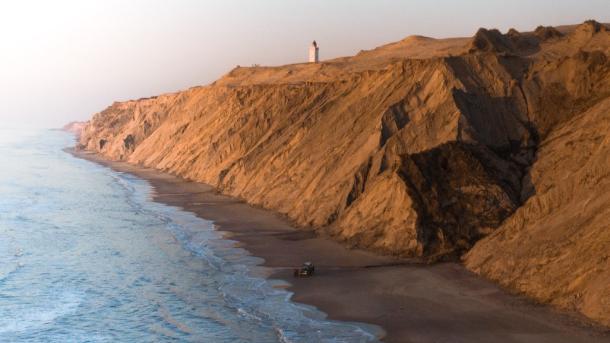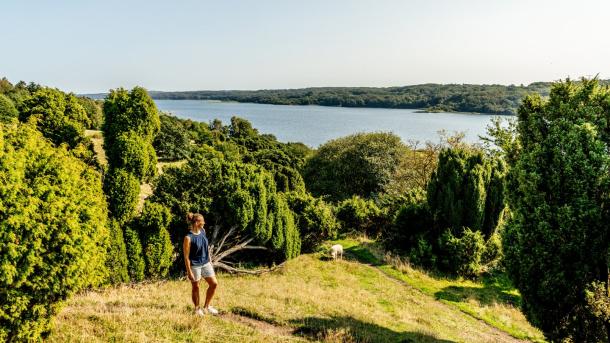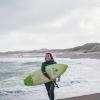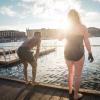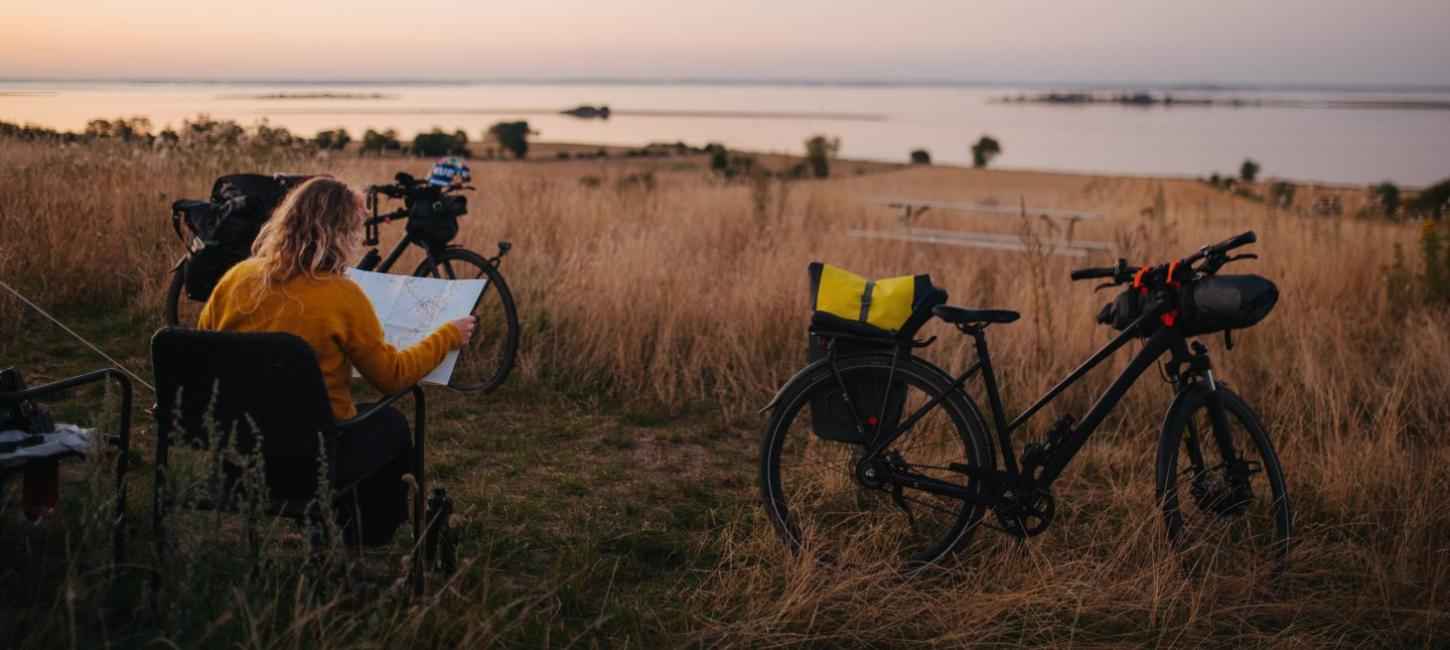
Denmark’s greatest cycling routes
With so many national, regional, and local cycling routes to choose from, where do you even start? We got you. Here are some of Denmark’s best cycling routes, all great options for a self-guided two-wheeled adventure throughout Denmark.
Cycling routes for everyone
From quick spins to epic rides (18-390 km), these routes are sorted by distance, so you’ll know just how sore you’ll be the day after! With Copenhagen Sprint bringing the world’s best cyclists to Denmark in 2025 and 2026, it’s the perfect place to shift gears and enjoy some wheel-y great vibes!
Panoramic Route 421: On top of the world (18 km)
Explore South Zealand on one of Denmark’s few mountain-like cycling routes. But you don’t have to be a mountain goat to climb the UNESCO Biosphere landscapes of the charming island Møn. The panoramic route 421 will take you through lush forests, Scandinavia’s first Dark Sky Park and past the stunning white cliffs of Møns Klint, where you can go hunting for fossils at the beach with GeoCenter Møns Klint.
The Best of the West (18,5 km)
Cycle along Denmark’s wild Northwest Coast on this stunning route from Løkken to Rubjerg Knude Fyr. Ride past wide sandy beaches, rolling dunes, and dramatic coastal cliffs before reaching the iconic Rubjerg Knude Lighthouse, now perched on shifting sands. From here, you can continue to the charming village of Lønstrup - either by following the inland route or, if the tide is low, cycling along the beach for a truly unique ride.
The architectural BIG bike tour (22 km)
Take a 22 km bike tour through Copenhagen and explore the groundbreaking designs of world-renowned architect Bjarke Ingels. Ride through vibrant neighbourhoods and shifting cityscapes, with plenty of chances to stop for great food, drinks, and cultural highlights along the way. And since Copenhagen is best explored on two wheels, there’s no better way to experience it!
Herning Rundt (28 km)
This 28 km route is a perfect blend of nature, sports, and culture, making it a great ride for both MTB enthusiasts and casual cyclists. Pedal past forests, lakes, and local landmarks like Elia and Birk’s art district, with stops at Fuglsang Lake for a swim or water activities. For those craving a bit more action, the singletrack trails in Gullestrup, Lind, and Knudmosebjerget offer an extra thrill. A fun and scenic way to experience Herning on two wheels!
Ørnbjergruten (34 km)
Cycle through the breathtaking glacial landscapes of Mols Bjerge National Park on this 34 km route through the Aarhus Region. You’ll ride past Stubbe Sø, one of Denmark’s largest lakes, and the charming Ørnbjerg Mølle, a historic watermill that makes a perfect stop for a scenic break. Shaped by the Ice Age, this route is a dream for nature lovers and cycling enthusiasts looking to soak up the area’s mix of wild landscapes and local history. Pack a picnic, enjoy the views, and if the water’s calling, take a dip before pedalling on.
The Big Five - Fanø (37 km)
Did you know Denmark has its own Big Five? You’ll find them on Fanø, where this 37 km cycle route takes you across the island’s five highest dune peaks, ranging from 15 to 21 meters. Each dune tells a story of Fanø’s shifting landscapes, and despite their modest height, the views from the top are spectacular. After your ride, head to the local brewery near Nordby in northern Fanø and toast to your adventure with a well-earned drink.
The route of Birds of prey (38 km)
Hop on your bike and set off along Denmark’s northeast coast on this easy, mostly flat ride through stunning coastal landscapes. Along the way, you’ll pass Råbjerg Mile, Denmark’s largest wandering dune, a sandy giant that’s always on the move. Keep an eye on the sky as birds of prey often glide above the dunes. As you continue south, you’ll follow the North Sea Cycle Route, where the salty breeze, open skies, and ever-changing scenery make for a ride you won’t forget.
One of Denmark’s toughest climb (50 km)
Up for a challenge? This tough 50 km route on Bornholm is home to the annual Mountain Cycling Championship and might just be Denmark’s most demanding climb. The short but intense 8 km ascent takes you from the idyllic harbour of Vang to Hammer Lighthouse, near Hammershus, Northern Europe’s oldest castle ruin. After conquering the climb, roll into Allinge for a well-earned break, cool off with local gelato from Sandvig Is Kalas or enjoy a cold, locally brewed beer at Ølstauan pub before taking on more of Bornholm’s rugged terrain.
The Castle Route: Odense to Kerteminde (58 km)
Curious to explore Fyn’s best-kept secrets? This stage of The Castle Route takes you from Odense to Kerteminde, weaving together everything that makes Fyn special. Pedal past roadside farm stalls, grand castles, and charming manors, with culture-filled detours and fresh local flavours along the way. The coast and countryside are always within reach, bringing that easygoing island vibe to your ride.
Berlin-Copenhagen Route: Stubbekøbing to Gedser (64 km)
One of the highlights of the long-distance cycling route between Berlin and Copenhagen is this 64 km stretch on Falster. Ride along the coastline with stunning views of both the fjord and sea, passing through deep forests and open landscapes. Stop in the cultural town of Nykøbing Falster before continuing to Pomle Nakke, a seaside restaurant perfect for a well-earned meal with an amazing view over the sea.
The Mariager Fjord Route (65 km)
Ready to explore 65 km of charming towns, rolling hills, and stunning fjord views? The Mariager Fjord Route (Route 32) takes you through Himmerland, with stops at the Fyrkat Ring Fortress, a UNESCO World Heritage Site, the picturesque town of Mariager, and the rugged Bramslev Bakker. Along the way, pick up local treats and settle in for the night at a cosy hotel, a traditional inn, or a scenic shelter spot under the stars.
The Castle Route 48 (75 km)
The best of North Zealand from a bike: Frederiksborg, Fredensborg, and Kronborg Castles, UNESCO-listed par force hunting landscape, leafy forests, sandy beaches, and beautiful views over Esrum Lake. This 75 km route forms a triangle between Hillerød, Helsingør, and Dronningmølle, following quiet country roads, cycle paths, and a gravel stretch through Gribskov. Along the way, history and nature go hand in hand, making it a ride to remember.
N8 Cycling Route: Kolding-Christiansfeld (96 km)
Explore a stunning stretch of the Baltic Sea Cycle Route (N8) as it winds through Kolding and the UNESCO-listed heritage town of Christiansfeld — famous for its gingerbread, so be sure to grab a bite. This 96 km ride offers more than beautiful scenery. It’s a journey through history, culture, and classic Danish charm in the heart of Jutland.
Around Ringkøbing Fjord (100 km)
This 100 km route circles Ringkøbing Fjord, starting from Hvide Sande Harbor or the historic market town of Ringkøbing, which is easy to reach by train or bus. The bike path winds through dunes and heathland, where the air is filled with the scent of beach roses, blueberry bushes, and pine. Along the way, you’ll pass Lyngvig Fyr, Denmark’s tallest lighthouse, as well as charming coastal towns with shops and restaurants — perfect for a well-earned break.
Fjord hopping on the East Coast Route (129 km)
The charming towns, rich cultural history, and diverse nature on the east coast of Jutland set the perfect scene for two-wheeled adventures. This 129 km long, signposted route follows the coastline from Norsminde, just south of Aarhus, to Vejle. Along the way, you will pass three fjords, beautifully forested rolling landscapes, and the cultural capital of Kystlandet, Horsens.
Solruten: The Sun Route (170 km)
Solruten is a scenic 170 km route that winds through Mors, taking you past quiet country roads, local attractions, museums, and artisan workshops. This is a ride to slow down, soak in the landscapes, and enjoy the rhythm of nature. Along the way, you’ll pass rolling farmland, forests, and striking moler cliffs, with the Limfjord always nearby offering stunning views. Sitting at the heart of the Limfjord, Mors brings together the best of Jutland’s landscapes in one place, ready to be explored.
Sønderjylland from Coast to Coast (236 km)
Warning: This one’s for the hardcore cyclists! This 236 km route takes you across the diverse landscapes of Sønderjylland, stretching from the North Sea’s sandy shores, through rolling hills and fjords, to the Baltic Sea on the east coast. Along the way, visit historic towns with their colourful houses, cobbled streets, castles, and centuries-old churches. Taste the local cuisine... and the history of the region.
The Fjord Route (275 km)
Cycle through Denmark’s stunning fjord landscape on the Fjord Path, a 275 km route where nature, history, and culture meet. Ride past Viking heritage sites, a UNESCO-listed area, quiet peninsulas, charming villages, and historic manors. Follow scenic paths along beaches and forests, with plenty of stops for local flavours along the way. Whether you’re up for adventure or a peaceful ride, Danish Fjordlandet has it all.
Ice Age Route (Istidsruten, 390 km)
Trace the footsteps of the Ice Age on this 390 km cycling and adventure trail, where glaciers shaped Zealand’s landscape 20,000 years ago. The route winds through forests, countryside, and fjords in five stages, offering a mix of scenic beauty and open-road freedom. Take on a short ride or a multi-day cycling holiday — either way, the well-marked, low-traffic paths make it ideal for both speedy cyclists and family-friendly adventures.
See the world's best cyclists race through Copenhagen
Copenhagen Sprint is an exciting new World Tour cycling race, that brings the world’s top cyclists to the Danish capital and beyond. After a successful first cycling festival in June 2025, it will return 20-21 June 2026. And let us tell you, it’s more than just a race, Copenhagen Sprint is a celebration of Denmark’s cycling culture. Take part in side events like a free public ride on the closed circuit or soak up the atmosphere at the lively bicycle festival packed with activities for all ages.
Got questions? We’ve got answers!
We know you might be wondering…
When is the best time to cycle around Denmark?
If you ask a Dane, there's no bad time to cycle around Denmark. But you might not agree with us...
The peak season for travel in Denmark is June-end August, when temperatures hit around 22◦C and there can be as many as 19 hours of daylight. Shoulder season (late spring and early autumn) is recommended for cyclists looking for quiet roads but reasonable temperatures. Winter (November-February) can be as cold as -1◦C and feels colder with wind chill.
Can I rent a bike on location?
The short answer is: YES! You don't have to bring your own bike if you'd rather not.
In Copenhagen, touring bikes can be rented from Baisikeli and Copenhagen Bicycles for longer trips outside the city. You can take bikes on trains and metros to reach your start point, or hire a bike in the destination on arrival.
Is it possible to go on a cycling tour?
Yes, there are multiple tour operators offering cycling holidays and tours in Denmark, including MTB Tours who offer mountain bike, multi-country trips and day trips. Cycle groups Rapha and Pas Normal Studios run group day trips that start and end in Copenhagen.
Do you have bike-friendly accommodation?
Yes we do! As bike enthusiasts ourselves, we totally get why you don't want to leave your darling bike outside in the cold.
The Bed + Bike scheme is a range of certified bike-friendly accommodation worth looking out. There are also basic shelters available for those who travel by kayak, bike or on foot from 30 kr per night, bookable via the Book en Shelter, Ud I Naturen and Naturstyrelsen websites.

